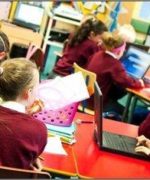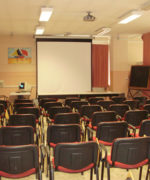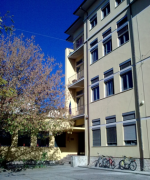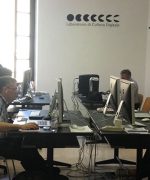LANDSCAPE REVIEW
INTRODUCTION
According to the European Commission’s 2013 Survey of Schools’1 findings,“…there is a strong case for further increasing efforts at school level to develop strategies concerning the use of ICT in T&L (teaching and learning) in order to benefit the large majority of students … Increasing students’ ICT-based activities during lessons, and as a consequence their digital competence, strongly needs to be boosted. Policies and actions to support a quantitative and qualitative increase in teacher professional development are probably the most efficient ways to obtain results in this area, especially given the interest shown by a large majority of teachers learning ICT in their own spare time … Policy makers should also dedicate attention to the creation and dissemination of good quality digital learning resources with the aim of increasing their use by teachers and students during lessons.”
The European Commission’s 2013 initiative Opening up Education2 concluded that there was an urgent need to “stimulateways of learning and teaching through ICT and digital content, and, amongst its actions, the most important one is to change the role of digital technologies at school”

Concern was expressed that Europe is falling behind in the digital sphere; the great majority of schools are not digitally equipped and their students are not taught by digitally confident teachers, rather teachers who mainly use ICT to prepare their teaching but not as a skill for students to develop in the classroom. In the background, remains the threat of facing a new digital divide between those who have access to innovative, tech-based education and the digitally excluded. The document states that an important element of the solution is to facilitate teachers to create communities of practice to exchange teaching materials and best practices.
“All educational institutions need to improve their capacity to adapt, promote innovation and exploit the potential of technologies and digital content…. Only an integrated approach, where access to digital content, ICT infrastructure, the right level of digital skills, and the right organisational strategies are secured, can generate an educational offer able to sustain innovation. Developments in the use of ICT and digital content have varied in the Member States. Many have recognized the potential impact of technology on education and many e-learning initiatives have been launched. However, initiatives have been fragmented and isolated; investments in infrastructure were often not accompanied by efforts to increase the capacity and motivation of teachers and learners to use it…. Sustained effort and on-going international cooperation is required to improve our knowledge-base and take full advantage of the impact of technology on education.”
Educational institutions from Denmark, Finland, Italy and the Republic of Ireland were actively engaged in a Erasmus + Strategic Partnership project since 2015 under the KA2 strand: Strategic Partnerships for School Education. A Digital Journey in Europe had key objectives to address in light of that context and mission identified by the European Commission:
- approaches and policies, both whole-school and those of individual teachers,
- software applications, including newly developed cloud-based systems,
- methodologies to make optimum use of available technology,
- varieties of hardware devices, including interactive whiteboards, desktop and laptop computers, tablet computers and hand-held devices,
- opportunities to utilise modern technology systems by students out of school hours, such as at home,
- solutions which will enable schools to reduce disparities in learning outcomes affecting children with special needs and those from disadvantaged and immigrant backgrounds,
- opportunities for organisations who normally operate outside the realm of schools to collaborate with and support schools’ use of modern technology.
The value of this collaborative project is reinforced by the findings of European Commission’s Joint Research Centre, Institute for Prospective Technological Studies, which lament the dearth of such cross-national opportunities to share and evaluate best practice in digital learning. A JRC Science for Policy Report (Promoting Effective Digital-Age Learning – A European Framework for Digitally-Competent Educational Organisations, 2015) states that the digital transformation of educational organisations is progressing at different rates, with different aims and outcomes in different regions and countries in Europe. As a result, there is little scope for mutual learning about best practices or about any failures in the process of integration or effective uses of digital learning technologies. Hence, there is a risk that cooperation opportunities are lost, work is duplicated and mistakes or sub-optimal implementations will be repeated…“Digital technologies are being incorporated in exciting and promising ways at all levels of education. To consolidate progress and to ensure scale and sustainability, education institutions need to review their organisational strategies, in order to enhance their capacity for innovation and to exploit the full potential of digital technologies and content”.
Primary school curricula in each of the four jurisdictions identify the use of ICT as a methodology to support teaching and learning, and there are significant similarities of policy approach that underpinned the philosophy and operation of this Erasmus project. European Schoolnet3has recently undertaken a review of national policy and provision of ICT in a number of countries throughout Europe and summarises key national policies and emphases.
DENMARK
In Denmark, ICT is incorporated across the Common Objectives, integrated in all subjects. There are no separate objectives for ICT in the curriculum. However, the curriculum is supplemented by a guideline on how to embed ICT and media in the academic subjects, including the expected role and students’ skills; IT and media as a cross curricular subject. Four student roles are highlighted in the specific objectives for each subject:
- The student as a critical investigator
- The student as an analysing recipient
- The student as a producer
- The student as a responsible participant
‘Digital awareness’ is part of the Danish language subject4 (i. e. awareness of the consequences of making certain remarks on the internet, digital footsteps).
Danish partners participating in the project:




FINLAND
ICT is not a subject of its own in the Finnish national curricula but it is one of seven transversal competences which should be included in all subjects. The goals of ICT skills should be described and included in all subjects in the local curricula.
The use of ICT is systematically embedded throughout the 9 years of general basic education, in different subjects, for integrative/thematic studies, and other forms of school work.
- Pupils are guided to understand the main functional principles, concepts and user logic of ICT, and develop their ICT skills by delivering their own outputs.
- Pupils are instructed to the safe and responsible use of ICT, and ergonomically sound working methods.
- Pupils are taught to use ICT for managing information, and inquiry-based and creative forms of work.
- Pupils get experience and practice on using ICT for interaction and networking purposes
The pupils’ opportunities to be active learners and work creatively, finding their own learning paths and learning styles, is important for all of the four areas. Of importance is also the joy of learning and working together, which affect learning motivation. The use of ICT offers pupils means to voice their thoughts and ideas in various ways, which develops thinking and learning skills. Pupils are guided to learn about different ICT applications and purposes of use, and take note of the significance of ICT in everyday life, interaction between people, and as an overall means to influence.
There is room for discussions on why ICT is needed in studies, in working life and society at large, and how ICT skills have become part of general working skills. The pupils are taught to measure the impact of ICT from the point-of-view of sustainability, and to act as responsible consumers. During the years of basic education, the pupils are also offered opportunities to interact in an international environment. They gain an understanding of the impact of ICT in the globalized world, the opportunities it offers and the risks involved5.
Finnish partners participating in the project:

IRELAND
In 1999, the Introductory Statement to the Primary School Curriculum in Ireland6 discussed ‘utilising the learning potential of information and communication technologies’ (NCCA, 1999, p21). ICT was listed as a methodology rather than a discrete subject, and in 2007 the National Council for Curriculum and Assessment (NCCA)7 produced a document called the ICT Framework: a structured approach to ICT in Curriculum and Assessment. The framework identified four areas of learning objectives;
- Creating, Communicating and Collaborating,
- Thinking Critically and Creatively,
- Understanding the Social and Personal Impact of ICT
- Developing Foundational Knowledge, Skills and Concepts.
Teachers were supported in achieving the 15 learning outcomes at three different age levels through the provision of sample activities on the action.ncca.ie website.
A Digital Strategy for Schools 2015-2020: Enhancing Teaching Learning and Assessment was published in October 2015. Most recently, the Digital Learning Frameworkwas launched in October 2017 and pilot schools have been selected to use this tool to evaluate their use of ICT with a view to national rollout in September 2018. The first departmental circular this year (cl0001_2017) set out a grant for ICT Infrastructure for every school in the country to seek to support schools in delivery of digital learning.
Irish partners participating in the project:




ITALY
The Italian Ministry of Education launched in 2007 a National Plan for Digital Schools8 (Piano Nazionale Scuola Digitale) to mainstream Information Communication Technology (ICT) in Italian classrooms and use technology as a catalyser of innovation in Italian education, hopefully contributing to new teaching practices, new models of school organisation, new products and tools to support quality teaching. This strategy was reviewed by the OECD in 2013 and revised in 2016 as the Italian National Plan for Digital Education (2015-2020). The Guidelines for the Curriculum are the reference framework for the curriculum, which individual schools, being largely autonomous, have to implement. Within these guidelines there are various competences. For example, the goals for primary schools are the pupils can use ICT and multimedia to develop their work in various subject areas, etc9 .
Italian partners participating in the project:




SUMMARY
While each of the partner countries in Europe has affirmed the value of ICT in Education, a recent study Overview and Analysis of Policies for the Integration and Effective Use of Digital Technologies in Education (DigEduPol) 2016: An analysis of Digital Education Policies in Europe and Beyond, JRC10 highlights that the practice in schools has yet to be fully realised. The value of engagement in such cross-European collaboration as this Erasmus+ project must be recognised as a response to the research evidence presented in this overview:
The serious underuse of digital technologies in formal education settings is widely acknowledged in current research. International surveys and studies have highlighted the negative implications of this underuse for learning outcomes and the need to take immediate action…. Given the limited participation of industry in the examined policies, reinforced co-operation with the private sector could trigger more investment and increased longevity of policies in digital education. The second dimension highlighted the need for digital education policies to foresee pedagogical aspects as well as technological infrastructure deployment. Although both aspects are present in many of the examined policies, pedagogical innovation needs to receive more attention in future digital education policies. Finally, the success of policies that apply a bottom-up stakeholder-driven approach suggests that more effort should be made to consult education partners/stakeholders and to involve these closely in designing and implementing future policies….
Despite the abundance of online content and tools today, many classrooms struggle to make full use of digital technologies. Often referred to as the “digital use divide”, today’s classrooms vary between active and passive use of digital technologies in education. Integrating technology effectively in teaching and learning involves careful consideration and interweaving with pedagogical practices to avoid technology from being treated as a stand-alone factor. Technology is a means to achieve the education objectives and not the aim in itself. Technology and learning & teaching need to be viewed as two dependent variables rather than two separate entities.
Author: Tony Sweeney, Froebel Department of Primary and Early Childhood Education, Maynooth University
Next section: USING ICT IN EDUCATION
REFERENCES
- European Commission, 2013. Survey of Schools: ICT in Education:Benchmarking Access, Use and Attitudes to Technology in Europe’s Schools.
Available at: https://ec.europa.eu/digital-single-market/en/news/survey-schools-ict-education - European Commission, 2013. Opening up Education. Available at: http://europa.eu/rapid/press-release_SPEECH-13-747_en.htm
- Available at: http://www.eun.org/resources/country-reports
- European Schoolnet, 2017. Country Report on ICT in Education – Denmark
Available at: http://www.eun.org/documents/411753/839549/Country+Report_Denmark_2017.pdf - European Schoolnet, 2017. Country Report on ICT in Education – Finland
Available at: http://www.eun.org/documents/411753/839549/Country+Report_Finland_2017.pdf/ - National Council for Curriculum and Assessment (Ireland), (1999) Primary School Curriculum: Introduction. Available at: https://curriculumonline.ie/getmedia/93de2707-f25e-4bee-9035-92b00613492e/Introduction-to-primary-curriculum.pdf
- National Council for Curriculum and Assessment (Ireland), 2007. ICT Framework: a structured approach to ICT in Curriculum and Assessment https://www.ncca.ie/media/2093/ict_framework_a_structured_approach_to_ict_in_curriculum_and_assessment_-_revised_framework.pdf
- OECD, 2013. Review of the Italian Strategy for Digital Schools
Available at: https://www.oecd.org/edu/ceri/Innovation%20Strategy%20Working%20Paper%2090.pdf - Available at: http://itec.eun.org/web/guest/it-current-curriculum
- Joint ResearchCentre – Institute for Prospective Technological Studies, 2016. Overview and Analysis of Policies for the Integration and Effective Use of Digital Technologies in Education (DigEduPol) 2016: An analysis of Digital Education Policies in Europe and Beyond, JRC.
Available at: https://ec.europa.eu/jrc/en/digital-education-policies
